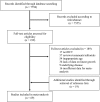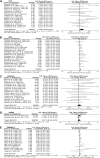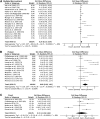The Impact of Nutritional Interventions beyond the First 2 Years of Life on Linear Growth: A Systematic Review and Meta-Analysis
- PMID: 28298275
- PMCID: PMC5347103
- DOI: 10.3945/an.116.013938
The Impact of Nutritional Interventions beyond the First 2 Years of Life on Linear Growth: A Systematic Review and Meta-Analysis
Abstract
A large body of evidence suggests that the first 1000 d from conception is a critical window in which interventions to address malnutrition will be most effective, but little is known about the impact on linear growth of nutritional interventions in children ≥2 y of age. The aim of this analysis was to evaluate the effectiveness of several nutrition-based interventions, specifically iron, zinc, calcium, iodine, vitamin A, multiple (≥2) micronutrients, protein, and food, at improving growth in children ≥2 y of age. A systematic search of MEDLINE and EMBASE retrieved 7794 articles. A total of 69 studies met prespecified inclusion criteria. Baseline height-for-age z score, age, nutrient dose, and study duration were examined as potential sources of heterogeneity. Zinc (mean effect size: 0.15; 95% CI: 0.06, 0.24), vitamin A (0.05; 95% CI: 0.01, 0.09), multiple micronutrients (0.26; 95% CI: 0.13, 0.39), and protein (0.68; 95% CI: 0.30, 1.05) had significant positive effects on linear growth, with baseline height-for-age z score as a significant inverse predictor of the effect size. Iron, calcium, iodine, and food-based interventions had no significant effect on growth. Age at baseline, study duration, and dose were not related to effect size for any nutrient examined. These findings suggest that zinc, vitamin A, multiple micronutrients, and protein interventions delivered after 24 mo of age can have a positive effect on linear growth, especially in populations that have experienced growth failure.
Keywords: 1000 days; calcium; iron; multiple micronutrient; protein; stunting; vitamin A; zinc.
© 2017 American Society for Nutrition.
Conflict of interest statement
Author disclosures: JL Roberts and AD Stein, no conflicts of interest.
Figures






Similar articles
-
Micronutrient supplementation in adults with HIV infection.Cochrane Database Syst Rev. 2017 May 18;5(5):CD003650. doi: 10.1002/14651858.CD003650.pub4. Cochrane Database Syst Rev. 2017. PMID: 28518221 Free PMC article.
-
Systemic pharmacological treatments for chronic plaque psoriasis: a network meta-analysis.Cochrane Database Syst Rev. 2021 Apr 19;4(4):CD011535. doi: 10.1002/14651858.CD011535.pub4. Cochrane Database Syst Rev. 2021. Update in: Cochrane Database Syst Rev. 2022 May 23;5:CD011535. doi: 10.1002/14651858.CD011535.pub5. PMID: 33871055 Free PMC article. Updated.
-
Multiple-micronutrient supplementation for women during pregnancy.Cochrane Database Syst Rev. 2017 Apr 13;4(4):CD004905. doi: 10.1002/14651858.CD004905.pub5. Cochrane Database Syst Rev. 2017. Update in: Cochrane Database Syst Rev. 2019 Mar 14;3:CD004905. doi: 10.1002/14651858.CD004905.pub6. PMID: 28407219 Free PMC article. Updated.
-
Nutrition-specific interventions for preventing and controlling anaemia throughout the life cycle: an overview of systematic reviews.Cochrane Database Syst Rev. 2021 Sep 26;9(9):CD013092. doi: 10.1002/14651858.CD013092.pub2. Cochrane Database Syst Rev. 2021. PMID: 34564844 Free PMC article.
-
Drugs for preventing postoperative nausea and vomiting in adults after general anaesthesia: a network meta-analysis.Cochrane Database Syst Rev. 2020 Oct 19;10(10):CD012859. doi: 10.1002/14651858.CD012859.pub2. Cochrane Database Syst Rev. 2020. PMID: 33075160 Free PMC article.
Cited by
-
Association between Dietary Practices and Growth Trajectories in Preschool Children.Am J Epidemiol. 2024 Jul 24;194(7):1909-16. doi: 10.1093/aje/kwae238. Online ahead of print. Am J Epidemiol. 2024. PMID: 39049447 Free PMC article.
-
Are Household Expenditures on Food Groups Associated with Children's Future Heights in Ethiopia, India, Peru, and Vietnam?Int J Environ Res Public Health. 2020 Jul 1;17(13):4739. doi: 10.3390/ijerph17134739. Int J Environ Res Public Health. 2020. PMID: 32630270 Free PMC article.
-
Disparities in children's vocabulary and height in relation to household wealth and parental schooling: A longitudinal study in four low- and middle-income countries.SSM Popul Health. 2017 Dec;3:767-786. doi: 10.1016/j.ssmph.2017.08.008. SSM Popul Health. 2017. PMID: 29302614 Free PMC article.
-
The Actions of IGF-1 in the Growth Plate and Its Role in Postnatal Bone Elongation.Curr Osteoporos Rep. 2020 Jun;18(3):210-227. doi: 10.1007/s11914-020-00570-x. Curr Osteoporos Rep. 2020. PMID: 32415542 Free PMC article. Review.
-
Milk and dairy consumption is positively associated with height in adolescents: results from the Israeli National Youth Health and Nutrition Survey.Eur J Nutr. 2022 Feb;61(1):429-438. doi: 10.1007/s00394-021-02661-6. Epub 2021 Aug 18. Eur J Nutr. 2022. PMID: 34406484
References
-
- UNICEF, WHO, World Bank. 2014 Joint child malnutrition estimates: levels and trends 2014. [cited 2016 Jun 17]. Available from: http://www.who.int/nutgrowthdb/jme_brochure2015.pdf?ua=1.
-
- Bhandari N, Bahl R, Taneja S. Effect of micronutrient supplementation on linear growth of children. Br J Nutr 2001;85 Suppl 2:S131–7. - PubMed
-
- WHO, FAO. Guidelines on food fortification with micronutrients. In: Allen L, de Benoist B, Dary O, Hurrell R, editors. Geneva (Switzerland): WHO; 2009.
Publication types
MeSH terms
Substances
Grants and funding
LinkOut - more resources
Full Text Sources
Other Literature Sources
Medical
Miscellaneous

